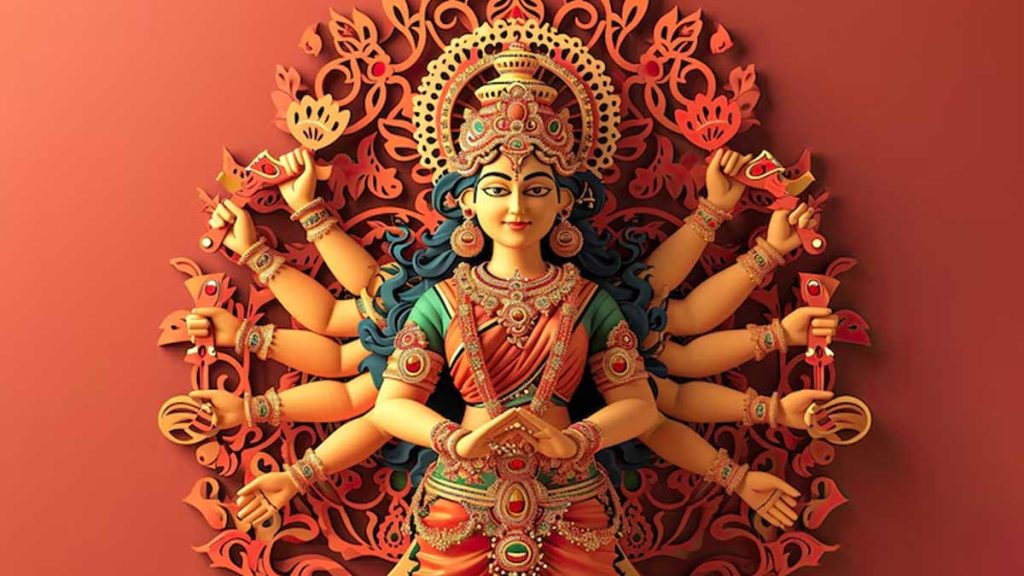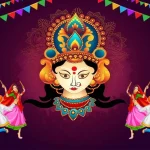Navaratri is an annual Hindu festival that spans nine nights and ten days, honoring the divine feminine power in the universe. The name “Navaratri” literally translates to “nine nights” in Sanskrit, reflecting the duration of this vibrant and spiritually significant celebration. While observed throughout India and in Hindu communities worldwide, the festival holds different meanings and is celebrated in various ways across regions.
At its core, Navaratri is dedicated to the worship of the goddess Durga, who represents the supreme feminine energy or Shakti in Hindu philosophy. Durga is revered as the mother goddess and the embodiment of power, wisdom, and protection. The festival celebrates her victory over the demon Mahishasura, symbolizing the triumph of good over evil.
The nine nights of Navaratri are typically divided into three sets of three days each, dedicated to different aspects of the divine feminine:
- The first three days are devoted to Durga, the warrior aspect of the goddess, representing power and action.
- The next three days honor Lakshmi, the goddess of wealth and prosperity.
- The final three days are dedicated to Saraswati, the goddess of knowledge and arts.
This division allows devotees to connect with different facets of the divine feminine energy, seeking strength, abundance, and wisdom in their lives.
Navaratri is celebrated differently across various regions of India. In North India, it’s often associated with the epic Ramayana, commemorating Lord Rama’s victory over the demon king Ravana. This culminates in the festival of Dussehra on the tenth day. In Western India, particularly in Gujarat and Maharashtra, Navaratri is marked by vibrant dance festivities like Garba and Dandiya Raas. In South India, the festival often focuses on the arrangement of dolls and figurines in a display called Golu.
One of the most visible aspects of Navaratri celebrations is the colorful attire worn by devotees. Each day of the festival is associated with a specific color, and participants often dress accordingly, adding to the festival’s visual splendor.
Fasting is another important aspect of Navaratri for many devotees. Some observe a strict fast for all nine days, while others may fast on the first and last days. The fasting is seen as a way to purify the body and mind, allowing for deeper spiritual connection.
The festival also has significant cultural importance. It’s a time for communities to come together, participate in group prayers, organize cultural programs, and engage in traditional dances. This communal aspect of Navaratri strengthens social bonds and helps preserve cultural heritage.
For many, Navaratri is a period of introspection and spiritual growth. The nine nights are seen as an opportunity to connect with one’s inner divine energy, overcome negative tendencies, and cultivate positive virtues. Some devotees use this time for meditation, chanting, or reading spiritual texts.
In recent years, Navaratri celebrations have evolved to incorporate modern elements while retaining their spiritual core. Many communities organize large-scale events featuring music concerts, fashion shows, and food festivals alongside traditional rituals and prayers.
It’s worth noting that while Navaratri is widely celebrated, its dates can vary. The festival typically falls in the Hindu lunar month of Ashvin, which usually corresponds to September or October in the Gregorian calendar. However, some regions in India celebrate Navaratri at different times of the year.
Navaratri is not just a religious observance but a celebration of life itself. It honors the cyclical nature of existence, the balance between creation and destruction, and the ever-present divine energy that permeates the universe. Whether through fasting, prayer, dance, or community gatherings, Navaratri offers a multifaceted approach to connecting with the divine and celebrating the power of femininity.
As we approach Navaratri in 2024, millions of Hindus around the world are preparing to immerse themselves in this vibrant festival, reaffirming their faith, strengthening community bonds, and celebrating the divine feminine energy that guides and protects us all.




Stay Ahead of the Market with Our Crypto Signals
Want to stay ahead in the crypto game Our crypto signals provide you with actionable insights for profitable trades No more uncertainty let us guide you through every market move with precision and accuracy
Daily signals for top cryptocurrencies
Trusted by traders worldwide
Easy-to-use platform
Join now and get your first signals for free
What a great story! I’m so glad you shared it. The data you supplied was both practical and simple to grasp. Your ability to simplify otherwise difficult ideas is much appreciated. Anyone interested in learning more about this subject would benefit greatly from reading this.
What i do not realize is in fact how you are no longer actually much more wellfavored than you might be right now Youre very intelligent You recognize thus considerably in relation to this topic made me in my view believe it from numerous numerous angles Its like men and women are not fascinated until it is one thing to do with Lady gaga Your own stuffs excellent All the time handle it up